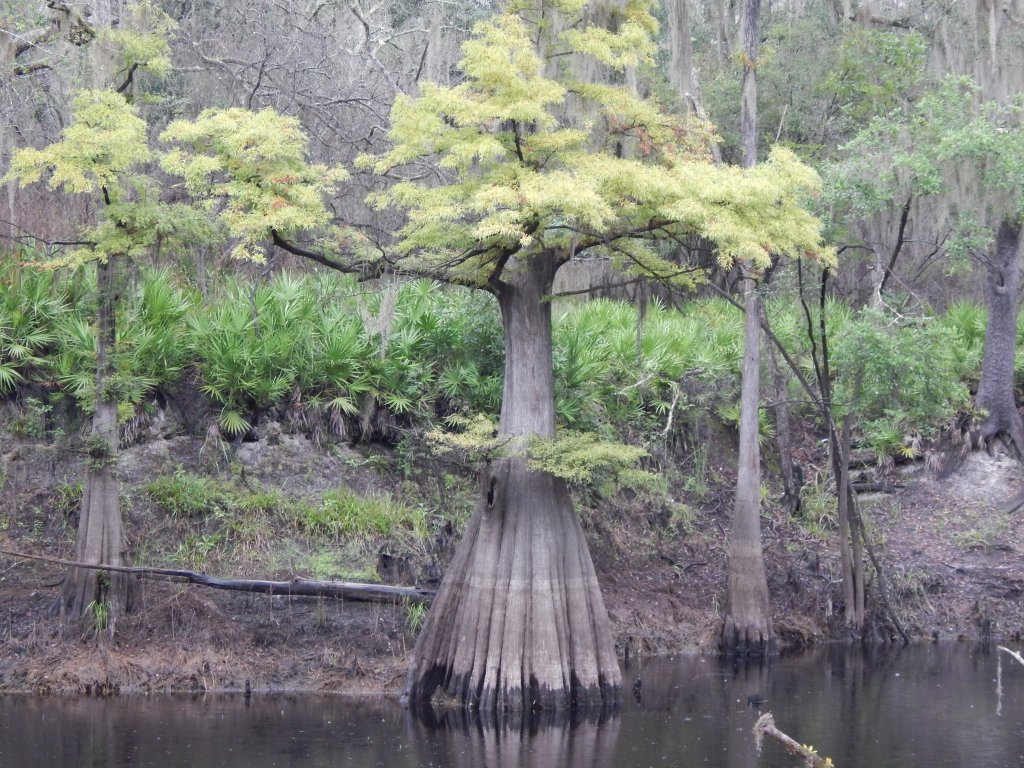The springs are running in White Springs-The odor is unmistakable
Published 10:39 am Thursday, September 26, 2013

- Years ago the water stayed at the white water mark on the cypress trees.
There’s something in the air in White Springs and it’s not the fragrance of blossoming flowers or trees. It’s a pungent odor of sulphur that is unmistakable, although, it is also a welcome sign that water conditions for North Florida could be improving.
Trending
White Sulphur Springs
As you walk down the wooden steps to the White Sulphur Springs spring house situated on the Suwannee River in White Springs, your nasal passages will soon be bombarded with the distinct odor of sulphur. The closer you get to the spring, the more intense the smell becomes.
Sometime in the 90s White Sulphur Springs dried up for the most part. In March, 2012, however, after a lot of rain pelted the region, the tannic water from the rising Suwannee River began to rush into the spring house. A few months later when Tropical Storm Debby flooded the area, the process reversed and water began flowing up from the spring and rushing out into the Suwannee as the spring house filled up with water.
“It flowed for nine days,” said local resident Ed Miller. “Every now and then, when we get the right amount of rain farther north, the spring runs for a couple days.”
Miller, who has explored and researched many of the local springs, explained that all the springs originally started out as sinkholes that developed years ago when ocean levels were lower. When water begins to flow upward through a sinkhole, he said, it is called a spring.
Thanks to generous rainfall amounts in Georgia over the last few months, on Monday, Sept. 23, White Sulphur Springs was in its glory again, pumping water up from the spring and out into the Suwannee River, filling the air with the lovely aroma of sulphur.
Trending
Blue Sink
Blue Sink is located on Suwannee River Water Management land off CR 136 near the I-75 interchange in White Springs. If you travel down NW 27th Road for a couple of miles you will run dead into it. The landscape is very primitive, except for a wooden boardwalk on one side of a large, very deep sinkhole. The rustic, natural atmosphere around the area will make you think you stepped into a time machine and went back 100 years.
Miller said Blue Sink probably flowed at one point in time, however, no one talks much about it, as it has a storied past.
“They’re all connected underground,” he said of the springs in the area. “When White Sulphur Springs flows, this one (Blue Sink) flows.”
There are distinct high water marks on many of the trees surrounding Blue Sink and locals who have lived in White Springs for many years, like Teddy Bear Marshall, say the water used to stay at those high levels all the time, according to Miller. Many people today still go there to do some fishing. On Monday, Sept. 23, while a steady rain fell, the fish were jumping.
Miller said there are many, many such places throughout North Florida and some are still undiscovered by the general public.
“There are ones that are flowing now that are hidden in the middle of nowhere,” he said.
The Floridan Aquifer
The Floridan Aquifer System, Miller said, is the world’s greatest natural resource. It has the two largest spring systems in the world, with over 1,200 springs, hundreds of underground rivers, and it has the largest natural cavern in the world.
“It’s bigger than the Grand Canyon, bigger than the Great Barrier Reef, it flows more water than Victoria Falls, and nobody knows it,” said Miller.
The Headwaters
Two weekends ago, Miller and his wife Helen went up to the Okeefenokee Swamp in order to better understand the headwaters of the Suwannee River. A park guide gave them a personal guided tour on a skiff through the swamp.
“We rode up the main channel of what becomes the Suwannee,” Miller said. “Up there they call it a lake, but it’s flowing just like the river.”
About 30 feet below the earth’s surface in that area is a hard cap made out of silica, which doesn’t dissolve, Miller explained. Then there are more layers of silica the deeper you go.
“It’s what the Indians made arrowheads out of,” he said.
After millions of years of acidic rainfall in the swamp area of Georgia, the upper layers of limestone eventually dissolved and basically formed a bowl that looks like a lake. When it overflows, the water comes southward into the Suwannee River.
“What’s happened since then is that muck from decayed leaves landed on the bottom of the lake where it formed gas,” said Miller. “The gas pushed the muck up to the surface and got into lilies and other stuff, so now, most of this thing is a lake with a layer of lilies and debris.”
The Indian name Okeefenokee means “land of the trembling ground”, which Miller explained is the ground floating above about 10-25 feet of water.
“After a while, it builds up so much that you end up with a 10 foot layer of muck in some places,” he said.
Comments from SRWMD
Senior Professional Engineer Megan Wetherington from Suwannee River Water Management District said, “The river has been flowing into the spring since late February. Two weeks ago, the river dropped enough that the pressure from groundwater was able to overcome the river. The spring reversed flow, and has been flowing out since.”
Wetherington explained the flow is a mixture of river water and groundwater, which is why it is both tea-colored (tannic) and smells like sulphur.
“As the river dropped, the flow has been increasing,” she said. “Last week it was flowing at 12 million gallons per day (MGD).”
Monday it was flowing at 37 MGD and was the highest measured flow since November, 2004, when it was slightly higher after the flooding from the hurricanes.
“It is flowing very fast, too,” she said.
The velocity of the discharge on Monday, Wetherington said, was five feet per second (about three and a half miles per hour). She added that groundwater levels in northern Suwannee/southern Hamilton counties are higher than normal, but not record-breaking.
“We don’t know if the spring will run clear after the river water is expelled, but the likelihood of this happening is the highest in years,” said Wetherington.
Looking forward
The fact that White Sulphur Spring and Blue Sink are both flowing is evidence that the two are connected by an underground river, White Springs Mayor Helen Miller said.
“We are truly fortunate that above normal rainfall in the Southeastern U.S. has delivered a temporary infusion to the Floridan Aquifer,” she said. “The current spring flow demonstrates that the physical properties of the spring are intact. This gives justification to the premise that if over-pumping to our east and north could be reduced substantially through conservation and reliance on alternate water sources, then the White Sulphur Spring could flow again on a permanent basis.”
If that happens, the mayor said the driver for the town’s economy could be restored.
At a meeting of the Florida League of Cities’ Energy & Environmental Quality Legislative Committee held in Jacksonville on Sept. 20, the unanimous consensus was that water will be a major issue for the 2014 session of the the Florida Legislature, mayor Miller explained.
“Officials representing the state’s 410 municipalities are making the argument loud and clear that water quantity, water quality, as well as salt intrusion and issues dealing with new federal designations of flood zones are major concerns that need the serious attention of the state’s lawmakers.”





